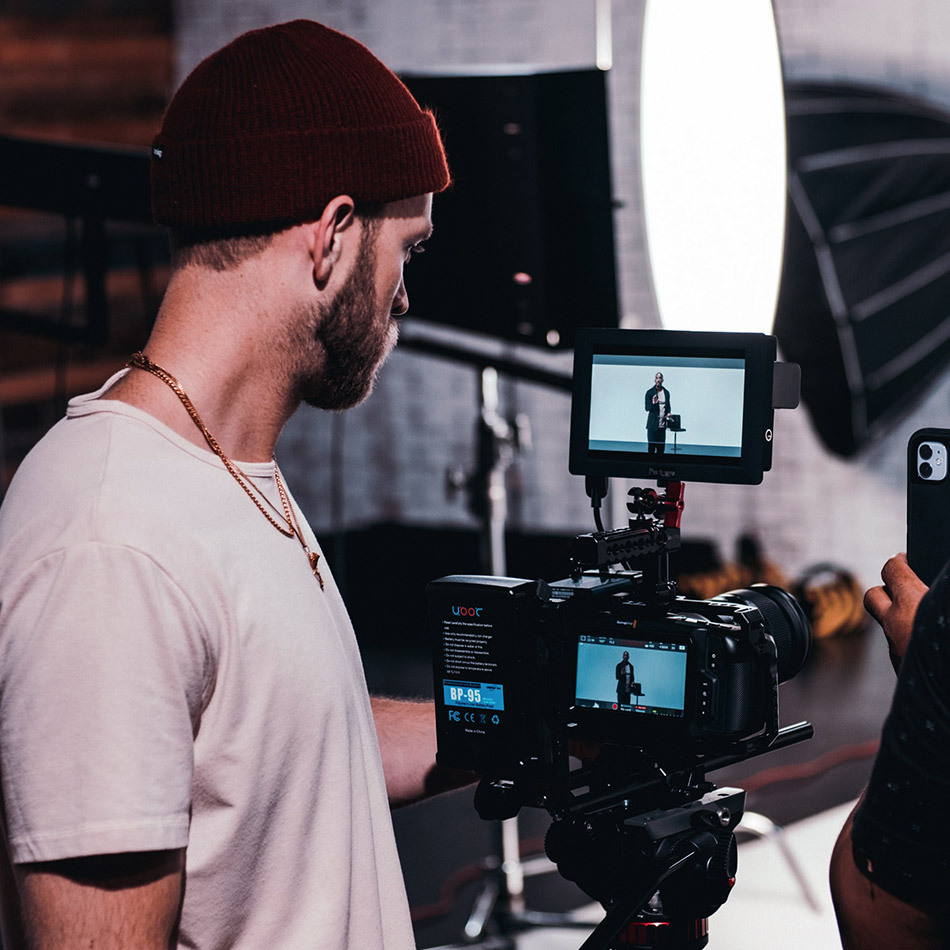Most filmmakers get asked to produce corporate interviews from time to time. They may not be the most desirable gigs in the world, but bills – or that new lens – don’t pay for themselves. For the client, an interview is an incredible opportunity to speak directly to their audience, so it has to sound good, otherwise you may not get a gig from that client again.
The main challenge in corporate interviews is that most CEOs are not screen-ready presenters. They speak regularly at conferences and meetings but they often don’t realise that a video is a very different stage. They tend to use a lot of jargon that most people won’t comprehend, they have a dizzying habit of going around in circles, or they provide non-answers by using vague language. But, after all, it’s not their job to deliver like an actor or a TV presenter.
Picture this: you go to a fancy office, get a set of questions and end up with a 50-minute, jargon-packed monologue that the PR execs expect you to turn into a punchy 6-minute piece. Sounds familiar? It doesn’t have to be that way.
Having conducted countless interviews in my career, my experience is that you can take control of any interview, even if you know little about the subject matter at hand. You can direct successful, well-spoken executives in order to get the best results. Often, you have to. The client is looking to your expertise to make their expertise shine.
I would like to give you a few tips on how to master one of the most common formats for corporate interviews and leadership pieces: the off-camera interview. With these tips, you should be able to easily create a single, engaging video of 4 minutes or longer.
Know your audience
The first question you should ask your client is so simple that it’s easy to overlook, “Who do you want to reach with this video?” Procurement managers? CEOs in energy? Or pensioners looking for investment opportunities?
Once you know who your audience is, try to wear their hat during the shoot and flag every time the client uses a piece of jargon, or takes a logical leap that might be unclear, and ask them to define or clarify the point they’re making.
It’s key to always check the level of knowledge the audience is likely to possess. The broader the target audience the less jargon you will want them to use. On the other hand, let’s say the film is for web developers, it’s safe to assume they will know their javascript from their jpegs.
Structure the interview
Think of your interview as a story. You should be able to break it down into chapters. A good way to put this to the test is to give each ‘chapter’ a working title. Here’s a structure I’ve often found to be successful. It’s based on outlining a problem and presenting a solution:
1. Setting the scene
Watch a few TED talks and you’ll find they often follow a tried and tested formula. They set the scene with:
- A problem – “Every minute, 10,000 companies are hacked worldwide.”
- A promise – “Imagine a world without poverty.”
- A definition – “Nanotechnology is the big business of small things.”
- An anecdote – “In ’88, Steve Jobs told me a secret that changed my life.”
- A simple but startling statement – “Time does not exist.”
Start your video with any of these tools to grab the viewer’s attention. If your client thinks there’s no problem, then suggest there’s no need for their solution – that’ll convince them. Let them think big: Big Problem, Big Promise, Big Picture. The objective is to get the viewer to care, not to overwhelm them with details.
2. Elaborating the problem
Proceed with a clear and detailed description of the problem. Why/where it occurs, what are its consequences? Can we quantify them? How much revenue is lost? If the problem is complex, have the interviewee address it in bullet points. Have them list the issues first, and then elaborate on each one.
3. Suggest a solution in principle
This is the point where many interviewees jump into a sales pitch. But it’s better to first ask them to explain, in principle, what it would take to reach a solution to the problem. What are the main considerations? What are the pitfalls? The objective is to establish your interviewee as an expert the viewer can trust as an expert the viewer can rely on for a solution to an important problem.
4. Specify the client’s solution
Here comes the core message. Ask the interviewee to describe their product or project and explain how it addresses the problem. Can they match each of their product’s features to the solution in principle? And don’t forget to broach the “Why us?” question. There must always be something (geographical reach, knowhow, sustainability standards, etc.) that sets them apart from competitors.
In some cases, the client may want to avoid mentioning their products because they want to make a thought leadership video and portray themselves as industry experts. That’s completely fine, as long as they can present their wisdom in a clear and informative way.
5. Conclude by looking to the future
There are several good patterns that work well here. One is looking to the future of the industry with the subtext “We are the makers of the future and we invite you to be part of it”. You can also complete the circle of problem-solution by adding a call to action. Make it punchy, make it short, and drive the core message home.
There are other templates but this is my favourite because it is simple, flexible and does not require a lot of pre-production. You can have several answers in each section. What matters is that you always know where you are in your story and where you will take it by the end of each block. You can see this problem-solution structure in action in one of my recent interviews:
Sell the structure to the client
It’s important to get everyone on the same page at the beginning. Discuss your chosen structure with the PR exec and the interviewee before you start rolling. Together, establish how each question serves a certain block of the narrative. If necessary, reshuffle or rephrase questions, then go for a take to see:
- How the speaker talks (rhythm, gestures, stuttering, pace).
- How clear the story is to you, their test audience.
- Note jargon and overused terms – define or eliminate them with a second take.
- Get an idea of their core message.
After the first take, stop and think of three things that you can remember most vividly and share these points with them. If they are not exactly what they want, you will have to re-craft some answers to clear up and strengthen their core message.
Remember, the PR team will have heard it a hundred times. You only heard it once. If anything is unclear to you, it will likely be unclear to the viewer. Proceed with another full take where you craft the answers with the client. Finally, add a couple of additional takes, to be safe.
Before you move on, ask yourself if there are any missing logical links because there were no questions about them. Don’t shy away from going off-script if you feel there is an elephant in the room. If you’ve spotted a logical gap, others will too.
Craft your client’s answers
Once the structure is clear, it’s time to make each answer clear and sharp as possible. A good answer starts with a strong statement. It then elaborates on the issue. Finally, it ends with a logical conclusion. It may include a case study, examples, etc. but the structure will be similar. Until you have a clear, powerful answer, work together! Here’s a typical conversation:
Client: “Typically, threat exposure is not the board-level concern it should be. It is often relegated to lower-tier executives who are not best-placed to have a holistic approach to business goals and they make the wrong kind of investments that may be good for security but completely removed from the business strategy as a whole.”
Director: Off the record, who are these lower-tier executives?
Client: The IT people in the basement.
Director: So, security is not just an IT thing?
Client: No. It has to support the profitability of the company – it’s too expensive to sell to the board otherwise.
Director: So is it correct to say:
“Security is seen as an IT problem, so it’s not part of business discussions. And as it’s not treated as a business problem – i.e. something that affects profit – it is very hard to convince a CEO to care enough about it and spend on it. That needs to change.”
Client: Yeah, that’s right.
Director: So, can you link these 3 logical blocks together?
Client: Sure. So, before I start, it’s:
1. “Security is more than an IT-issue, it’s a business problem”
2. “The board only cares about business”
3. “If security is seen as a business problem, the board will care and spend on it.”
Director: Exactly.
And then you give it a few tries in plain English. It helps to ask them to talk to you in a way that fits the level of understanding of an 18-year old college student. That usually gets rid of some of the jargon, as well. Whatever structure you choose for the answer, the process is the same:
1. Listen.
2. Break down the answer to its logical building blocks.
3. Reassemble the answer with very clean logic.
4. Have it approved and delivered by the interviewee
It’s best not to give a verbatim answer and expect the interviewee to repeat it. Not only does it look bad, but it’s also probably not going to work. You can suggest logical prongs, rhetorical devices or even vocabulary (“Is this a ‘challenge’, a ‘problem’ or a ‘roadblock’? Which one describes it best in your view?”) but the answer has to be their own and it should not be scripted. Lastly, always seek input from the PR execs behind you; remember it’s a joint effort.
Use rhetorical devices
Rhetorical devices can make answers clearer, punchier, and more memorable. They help capture and maintain the viewer’s attention. Some rhetorical devices that work well:
- Metaphors – “Trying to avert automated cyberattacks without using any automation is like trying to intercept rockets with arrows.”
- Rhetorical questions – “Do you think your firm is too small to be worth hacking?”
- Repetition – “It’s your company. It’s your life’s work and it’s valuable. But how valuable exactly?”
- Rule of Threes – “Writing is rewriting, rewriting, and finally, rewriting.”
- Myth-busting – “Most people think that fossil fuels are here to stay till mid-Century… and therefore most people are wrong.”
- Syllogism – if A = B and B = C then A = C
When it comes to rhetorical devices, the key is moderation. Over time, you will easily find the one that can augment each answer the most.
Apply these methods anywhere
These techniques are rooted in journalism and therefore can be applied to a range of non-fiction content.
In a news piece or documentary, you will be critical and won’t make answer suggestions to the interviewee. Nevertheless, you should always strive for a clear and structured interview, bust unnecessary jargon, and look behind the rhetorical devices used by your interviewee.
I believe that conscious storytelling makes us better filmmakers. Studying these techniques has helped me a lot with my interviews and I hope they will work for you too.

